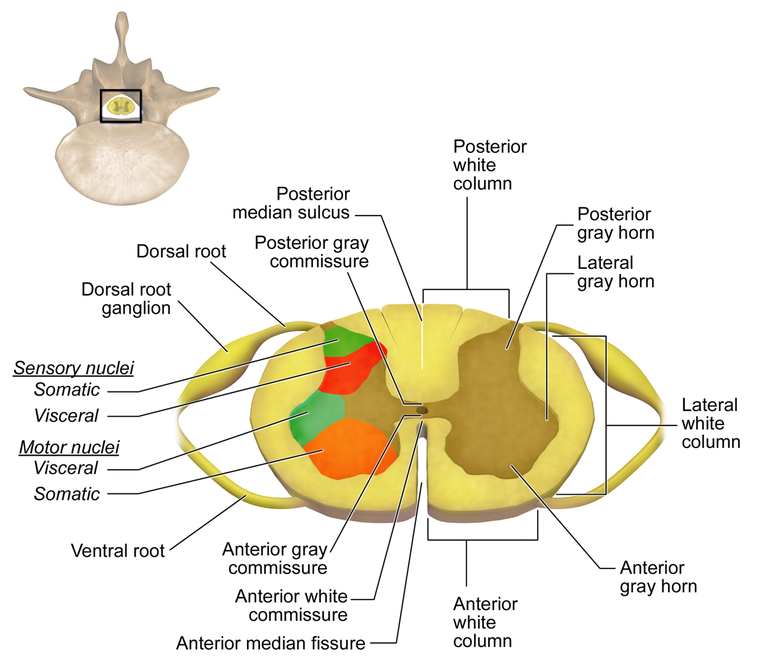The ultimate goal of neuroscience – the science of the brain and nervous system and cognition1Cognition is “the mental action or process of requiring knowledge and understanding through thought, experience and the senses.” (Wikipedia) – is to understand the workings of the mind and of consciousness – with treatment of disease taken up along the way. Much is known, much is not. Some think the search to understand consciousness to be a fruitless quest, but we will not consider their arguments here.2Such people include linguist and political observer Noam Chomsky and the researcher quoted as saying, “If the human brain were simple enough to understand, we would be too simple to understand it”. (Quoted in Openstax Anatomy and physiology. So this chapter will be less conclusive than the others. We will look at an overview of the physical structure of the brain, the central and peripheral nervous systems, input from the sensory system and output to the motor system, how it works in terms of neuronal connections and some ideas on how memories are formed, And, of course, these subjects will again bring up our old friends – energy and communications. As a matter of fact, that is what the nervous system is all about – using energy to communicate.
Neurologists distinguish two interacting parts to the human nervous system, the central and peripheral nervous systems.
The central nervous system
The central nervous system (CNS) is contained within the brain and the spinal column, and so is surrounded by bone. It is composed of the following parts, from top to bottom.
- The cerebrum is the largest part and at the top. Much more on it later.
- The cerebellum (“little brain”) is below the cerebrum and is concerned primarily with motor control.
- The brain stem (or brainstem) lies between the spinal cord and the rest of the brain. It is the source of ten of the twelve cranial nerves and is a passage for nerves from the sensory and to the motor systems.
- The spinal cord runs from the brainstem down through the vertebral column and carries connections between the central and peripheral nervous systems.
The peripheral nervous system
The peripheral nervous system (PNS) is composed of nerves and ganglia (singular ganglion, a clump of neurons in the PNS) which lie (mostly) outside the spinal column. In the CNS, a similar clump of neurons is called a nucleus. To make things more complicated yet, a bundle of axons in the CNS is called a tract; in the PNS, a nerve.The PNS has two divisions:
- The somatic nervous system (or sensory-somatic) does conscious control, sending commands from the CNS to voluntary muscles in order to control body movements. It also receives information from the body – the skin, skeletal muscle and sense organs.
- The autonomic nervous system controls the glands, heart and involuntary muscles, usually without our being conscious of it. It is in turn considered in two parts:
- The sympathetic nervous system prepares the body for immediate action, e.g., for defense (“fight or flight”), by shutting down processes that can be dispensed with temporarily, like digestion, and augmenting processes like heartbeat and blood pressure. Sympathetic NS nerves originate in the thoracic and lumbar regions of the spinal cord.
- The parasympathetic nervous system controls normal, resting homeostasis. It originates in the cranial nerves and the sacral region of the spinal cord.
- Many scientists consider a third component, the enteric nervous system, which manages digestion.

Somatic, autonomic and enteric nervous systems, from Openstax College
The two nervous systems are articulated in or around the spinal cord, which can be considered the bridge between the two, and hence between the brain and the body’s motor system.

Regions and segments of the human spinal cord, after Gray’s Anatomy via Wikimedia. Regions are cervical (red), thoracic (blue), lumbar (yellow), sacral (green) and coxxygeal (red, at the bottom).
Thirty-one pairs of spinal nerves, bundles of axons which enter or leave the spinal column at different levels, pass through notches between adjacent vertebrae. They are labeled by the region and the number of each vertebra. For instance, vertebrae C1 to C7 originate in the cervical region. Each one connects to parts of the body at that level or below it: The top connects to muscles and sensory receptors from the neck; the bottom, to the toes.
Afferent (incoming), sensory axons enter the spinal cord by the dorsal root and their cell bodies are grouped just outside the root in ganglia, the dorsal root ganglia.

Spinal cord section, by “BruceBlaus” via Wikimedia Commons
Efferent axons leave by the ventral root, but once outside, share the spinal nerves with the afferent axons. Motor neuron cells have their cell bodies inside the spinal cord.
In addition, there are twelve (or thirteen, according to definition) pairs of cranial nerves which emerge directly from the brain and brain stem. They are numbered by Roman numerals. Among them, the terminal, olfactory and optical nerves emerge from the cerebrum, the others from the brain stem. They are considered part of the PNS.
Muscle activation spans a range from involuntary, automatic movements (e.g., blood vessel contraction or pupil dilation), through conscious, reflexive movements (withdrawal from burning objects) and on to planned, conscious movements (walking). All require that input from sensory receptors in the region concerned be coordinated with movement planning in order to adjust and refine control.
Now let’s go on to look at the overall structure and evolution of the brain.
Notes
| ↑1 | Cognition is “the mental action or process of requiring knowledge and understanding through thought, experience and the senses.” (Wikipedia) |
|---|---|
| ↑2 | Such people include linguist and political observer Noam Chomsky and the researcher quoted as saying, “If the human brain were simple enough to understand, we would be too simple to understand it”. (Quoted in Openstax Anatomy and physiology. |


